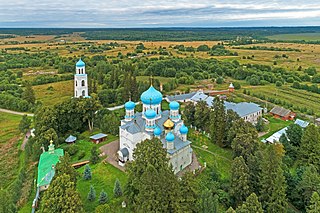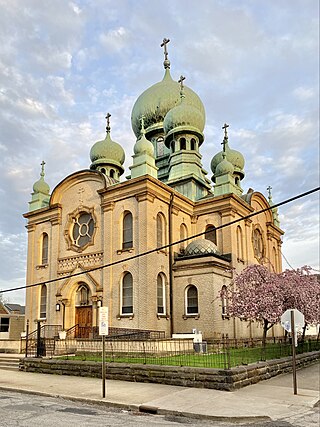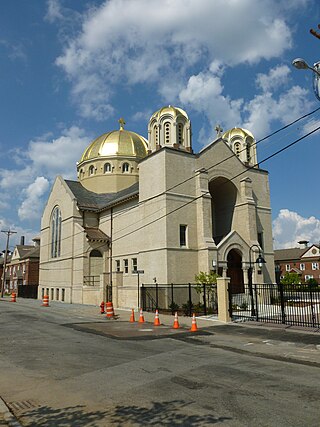
Wilkeson is a town in Pierce County, Washington, United States. The population was 499 at the 2020 census.

Neo-Byzantine architecture was a revival movement, most frequently seen in religious, institutional and public buildings. It incorporates elements of the Byzantine style associated with Eastern and Orthodox Christian architecture dating from the 5th through 11th centuries, notably that of Constantinople and the Exarchate of Ravenna.

An onion dome is a dome whose shape resembles an onion. Such domes are often larger in diameter than the tholobate (drum) upon which they sit, and their height usually exceeds their width. They taper smoothly upwards to a point.

The Holy Trinity Cathedral, also known as Holy Trinity Greek Orthodox Church, is a Greek Orthodox Church in Salt Lake City, Utah, United States. Built in 1923, the church was listed on the National Register of Historic Places in 1975.

Holy Trinity Orthodox Cathedral is the cathedral church of the Orthodox Church in America Diocese of the Midwest. It is one of only two churches designed by Louis Sullivan, one of the seminal architects of the late 19th and early 20th centuries. It is listed on the US National Register of Historic Places and is designated a Chicago Landmark.

Ukrainian Village is a Chicago neighborhood located on the near west side of Chicago. Its boundaries are Division Street to the north, Grand Avenue to the south, Western Avenue to the west, and Damen Avenue to the east. It is one of the neighborhoods in the West Town community area, and has one of the largest concentrations of Ukrainians in the United States.

Eastern Orthodox church architecture constitutes a distinct, recognizable family of styles among church architectures. These styles share a cluster of fundamental similarities, having been influenced by the common legacy of Byzantine architecture from the Eastern Roman Empire. Some of the styles have become associated with the particular traditions of one specific autocephalous Eastern Orthodox patriarchate, whereas others are more widely used within the Eastern Orthodox Church.

St. Theodosius Cathedral is an Eastern Orthodox church located on Starkweather Avenue in the West Side neighborhood of Tremont in Cleveland, Ohio. Considered one of the finest examples of Russian church architecture in the United States, it is listed on the National Register of Historic Places. St. Theodosius was the first Eastern Orthodox parish in Cleveland and is currently under the jurisdiction of the Diocese of the Midwest of the Orthodox Church in America. The cathedral is perhaps best known for its appearance in the 1978 Best Picture-winning film, The Deer Hunter, with Robert De Niro, Christopher Walken, and Meryl Streep. It is also seen in the opening credits of Major League.

Holy Trinity Greek Orthodox Church is a historic Greek Orthodox Church building at 62 Lewis Street in Lowell, Massachusetts. Holy Trinity is one of the many Eastern Orthodox churches in Lowell, along with St. George Antiochian Orthodox Church, Transfiguration of Our Savior Greek Orthodox Church, and St. George Greek Orthodox Church. The church is under the jurisdiction of the Greek Orthodox Archdiocese of America and is locally administered by the Metropolis of Boston. The church is located the Downtown Lowell neighborhood known as The Acre. It was built in 1906 and added to the National Register of Historic Places in 1977. Holy Trinity was the first church built for a Greek Orthodox congregation in the United States. It is known for its golden dome, mosaics, iconography, and rich history.

Wooden church architecture in Ukraine dates from the beginning of Christianity in the area and comprises a set of unique styles and forms specific to many sub-regions of the country. As a form of vernacular culture, construction of the churches in specific styles is passed on to subsequent generations. The architectural styles vary from very simple to complicated, involving a highly skilled carpentry and exceptional artistry in wood-cutting.

The Holy Resurrection Orthodox Church is a historic Eastern Orthodox Church building on Petrograd Street in Berlin, New Hampshire. The church is known locally as "The Russian Church" because it was built in 1915 by immigrants from the Russian Empire who were mostly from the provinces of Grodno, Volyn, and Minsk in modern-day Belarus and Ukraine. The church closed in 1963 but reopened in 1974 for the funeral of a Russian immigrant from modern-day Belarus, named Eugenia (Tarasevich) Tupick. It was added to the National Register of Historic Places in 1979 and is part of the Orthodox Church in America (OCA).

Fairfax was a coal town in Pierce County in the U.S. state of Washington. The town was located on the Carbon River about 6 miles (10 km) south of Carbonado, Washington, on SR 165. Mining lasted only until the minerals ceased to be economically viable following World War I. Until the completion of the nearby 240 feet (73 m) high O'Farrell Bridge in 1921, the town was only accessible via railroad or pack train.

The Saint Sava Serbian Orthodox Church is a Serbian Orthodox church in Jackson, California. Built in 1894, the church was the first Serbian Orthodox church in America. Amador County had a large Serbian-American population in the late 1800s due to the California Gold Rush, and the county's Serbs established the St. Sava Church Organization of Amador County in 1886–87; the organization was responsible for purchasing land for and building the church, and the effort was led by Sevastijan Dabović. The church's original design had an Eastern Orthodox influence, complete with an onion dome; while the dome was later replaced by a bell tower, the church's stained glass windows and use of icons still give it a distinctive Eastern Orthodox character. The church has been used for Serbian-American religious and social activities since its opening and is now part of the Serbian Orthodox Eparchy of Western America.
Transfiguration of our Lord Russian Orthodox Church is a Russian Orthodox church is located in Baltimore, Maryland. The church belongs to the Eastern American diocese of the Russian Orthodox Church Outside Russia.

The Russian Orthodox Cathedral of the Most Holy Trinity is an Eastern Orthodox church building in Buenos Aires, Argentina. Located in the neighborhood of San Telmo, in front of Lezama Park.

Wilkeson Arch is a monumental gateway structure at the west entrance to Wilkeson, Washington. The stone and timber structure was built in 1925 by the Wilkeson Booster Club, at a cost of $2000. It is similar in design to the Chinook Pass, Nisqually and White River entrance arches in nearby Mount Rainier National Park, deriving its style from the National Park Service Rustic style prevailing in the national park structures of the time. The arch was intended to promote tourism and the local products, coal and sandstone.

Wilkeson School is a public elementary school building in Wilkeson, Washington. Built in 1912 and still in operation, making it the oldest elementary school in Washington still in use, it was added to the National Register of Historic Places in 1976.

The Carlson Block is a pizza restaurant in a century-old building in Wilkeson, Washington. The sourdough crust pizza, described as "the best in Washington state" by The Seattle Times, is made in a wood-fired oven by chef and owner, Ian Galbraith. The restaurant opened c. early 2017, six years after the owner created the sourdough mother. Galbraith graduated from Fife High School and later attended Culinary Institute of America.

The Wilkeson Coke Ovens are from the early industrial period in Washington. The ovens are a result of the growth of the railroad in Puget Sound. Washington's coal industry was an enterprise with much promise but has never grown. It has remains a subdued element in the history of the Puget Sound Region. The Pierce County beehive coke ovens, of which those at Wilkeson were the most numerous and active, were the sole supply of coke in the coastal area. The coke ovens were added to the National Register of Historic Places on June 10, 1974.

The Wilkeson Community House, also known as Wilkeson Town Hall, is a town hall building in the community of Wilkeson, Washington, United States. It was built in 1923 and served several functions during the town's growth and development, particularly the needs of European immigrants. It is listed on the National Register of Historic Places.




















